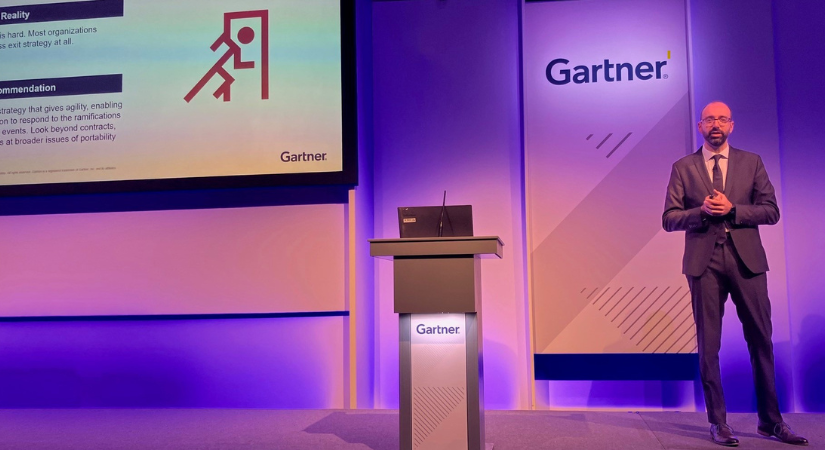A cloud strategy is a concise viewpoint on the role of cloud computing in the organisation. However, business and IT leaders continue to make 10 common mistakes when crafting their cloud strategy, according to Gartner, Inc.
“A good cloud strategy should be a short and consumable document, consisting of 10 to 20 pages or slides,” said Marco Meinardi, Vice President Analyst at Gartner. “In addition, the business strategy should drive the cloud strategy and provide guidance to those who will implement it. It must coexist with other strategic efforts, not try to redo them.”
Gartner analysts are discussing how to enable and exploit cloud, and demonstrate value at the Gartner IT Infrastructure, Operations & Cloud Strategies Conference 2022, which is taking place here through Tuesday.
Business and IT leaders should collaboratively build a cloud strategy and avoid the following 10 mistakes when building their cloud strategy:
- Assuming it’s an IT (Only) Strategy – Cloud computing isn’t only about technology. Those outside IT have skills and knowledge critical to cloud strategy success. “Business andIT leaders should avoidthe mistake of devising an IT-centric strategy and then trying to “sell it” to the rest of the business,” said Meinardi. “Business and IT should be equal partners in the definition of the cloud strategy.”
- Not Having an Exit Strategy – Devising an exit strategy from cloud providers is difficult, which is one of the reasons why many leaders don’t create one. Many organisations believe they don’t need an exit strategy because they don’t expect to bring anything back from the cloud. However, an exit strategy is vital to the success of an organisation’s cloud strategy. “It’s like having an insurance policy in your drawer, that you hopefully will never need to use,” said Meinardi.
- Combining or Confusing a Cloud Strategy with a Cloud Implementation Plan – A cloud strategy is different from a cloud implementation plan and a cloud strategy must come first. It is the decision phase in which business and IT leaders decide the role that cloud computing will play in the organisation. A cloud implementation plan comes next, putting the cloud strategy into effect.
- Believing It’s Too Late to Devise a Cloud Strategy – It is never too late to begin a cloud strategy. “If organisations drive cloud adoption without a strategy this will ultimately cause resistance from individuals who are not aligned on the strategy’s key drivers and principles,” said Meinardi. “As a result, this resistance will slow down cloud adoption and potentially jeopardise the entire cloud project.”
- Equating a Cloud Strategy with “We’re Moving Everything to the Cloud” – Many organisations assume that having a cloud strategy implies moving everything to the cloud. “This approach deters many business and IT leaders from devising a strategy because they think it means they’ll be forced to start using cloud computing for everything,” said Meinardi. “Organisations should keep an open mind and partner with a non-cloud technology expert, such as an enterprise architect, who can bring a broad viewpoint in the definition of your cloud strategy.”
- Saying “Our Cloud Strategy Is Our Data Center Strategy” – Many organisations confuse their cloud strategy with their data center strategy. While organisations need to keep them separate, they need to ensure they align with each other because that affects the role that cloud computing will play in their organisation. “Cloud strategy decisions are workload by workload, not data center decisions,” said Meinardi.
- Believing That an Executive Mandate is a Strategy – Another common mistake that organisations make is to adopt cloud computing because the CEO, CIO or the head of a business unit believes that doing so will result in cost savings. Gartner analysts recommend treating executive mandates as sponsorship to devise a cloud strategy and not as a cloud strategy in and of itself. The cloud strategy should also keep the connection to the business, ensuring that organisations know why workloads are moving and what the goal is.
- Believing That Being a <Fill in Vendor> Shop Means That Is the Cloud Strategy – Organisations will likely use several different cloud services over time. As the use of cloud services could become increasingly broad and diverse, business and IT leaders should devise a broad strategy by accommodating multiple types of scenarios, cloud services, vendors and non-cloud environments.
- Outsourcing Development of Your Cloud Strategy – Outsourcing an organisation’s cloud strategy may sound attractive but should not be done – it is far too important to outsource. Instead, Gartner analysts recommend that business and IT leaders use third parties — even the cloud provider — for implementation. This can be a cost-effective way of procuring the scarce cloud skills their organisation needs.
- Saying “Our Strategy Is Cloud First” Is the Entire Cloud Strategy – A cloud-first approach means that if someone asks for an investment, the default place for them to build or place the new asset is in the public cloud. “But cloud-first doesn’t mean cloud only. If business and IT leaders adopt a cloud-first principle, their strategy should work out the exceptions to the default choice that will make applications and elsewhere other than in the cloud,” said Meinardi.










Discussion about this post